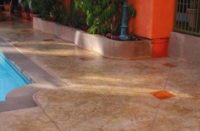Carlton Concrete offers three core services – concrete stamping, staining and overlay.
Doug Carlton says he tried his darnedest to stay out of the decorative concrete market. With both his father and grandfather traditional concrete contractors, he was quite content to maintain the status quo when he started his own company back in 1987. But so many clients kept asking for colored and “printed” concrete that in 1992 he “took a leap of faith” and entered the decorative realm. “It was the right move at the right time,” he says.
Today, in addition to the basics, Carlton Concrete offers three core services — concrete stamping, staining and overlay.
When he started flirting with the prospect of offering stamped concrete, he cut his first eight to 10 customers great deals. “If I had a patio that was going to be a broom job, I’d offer to stamp it at the same price,” he says. “This allowed me and the crew to learn on the job, to gain experience without a huge weight on our shoulders. It really took the pressure off.”
If there was one thing he learned then that still rings true today, it is that you’ve got to realize you aren’t going to produce a flawless creation. “It’s impossible to do perfect work day in and day out,” he says. “This line of work is meant to have imperfections. It’s not about going out and trying to do a perfect job. It’s about fulfilling the expectations of the client.”
He urges newcomers to the business to start off with a small project and take good pictures of the perfect areas and the imperfect areas. “Show them to everybody you can,” he says. “People relate to visuals.”
That’s the reasoning behind his latest business venture, a 5,000-square-foot design center that should be completed next spring. “People need to see decorative concrete, to feel it under their feet. They need to be able to visualize a mocked-up room and to see how it will fit into their home or office,” Carlton says.
Plans for the center include outfitting four offices with different treatments that will illustrate stamping, staining and overlay possibilities. Outside, there will be a fully landscaped area with different forms of stamped concrete so people can see what concrete will look like as it weathers and wears. Showing clients only newly placed concrete is like showing a bride only on her wedding day, Carlton says. “It’s just not a realistic picture.”
The showroom will also feature two finished floors that have one major difference: One is properly maintained and one is neglected. That way, customers can see the difference between the two and understand why some surfaces need to be periodically resealed.
Along with examples of decorative concrete, Carlton says, he will take advantage of today’s computer software. Customers will be able to meet with a designer who will input details into the computer to generate a sketch or blueprint of their project. “This way they’ll get a feel for what they like by seeing an overlay of different colors and patterns. They’ll leave with a little sketch to take home.”
And whereas variety is nice, Carlton notes, you don’t have to go overboard. “Most people will pick from what they see and will buy from what you show them. We have maybe one client a year that will ask for something they’ve seen that we don’t have.”
Of his stamping tools, he says, “we only use nine different styles and we tend to use the same three patterns weekly,” textured stone, ashlar slate and random stone. “There’s such a learning curve with stamping, and it’s best not to try to master too many things. My decorative crew becoming comfortable with different styles of stamp mat and application has been the key to multiple successful jobs. They’re the reason for our success.”
Education, too, is important. “There are a lot of people who want to get into business, but there’s a huge deficit in training and education,” Carlton says. “There’s a big difference between knowing how to do decorative work and doing the actual job.”
Carlton certainly doesn’t regret taking the leap into decorative concrete.
“Even at the end of a long, hard day, when it seems like we’re shoving 40 hours of work into an eight-hour day, I find myself turning around and taking a second peek at what we’ve done. I get satisfaction knowing we created something working together as a team, each doing their part to create a form of art, and that’s pretty cool. I love it. A lot of people can’t say that about their work.”
Media attention benefits entire trade
Last spring, Carlton Concrete’s work was featured in an episode of Extreme Makeover: Home Edition that involved refurbishing a home for eight kids whose parents had both recently died. The hardest part of the project, Carlton says, was doing a two- to three-day job in five to six hours — with the TV cameras rolling all the while.
Their work was such a hit that the show’s producers invited them back to participate in four more shows this season.
The exposure is not just good for his company, Carlton points out. It’s good for the whole industry. “People can turn on their TVs on Sundays and see stamped concrete and how it fits into a beautiful home setting. And a certain number of them will choose decorative concrete for their own project. I mean, there’s a guy in Minnesota who will benefit from me stamping a project in Northern California. It’s opening the market for everybody in the business.”























